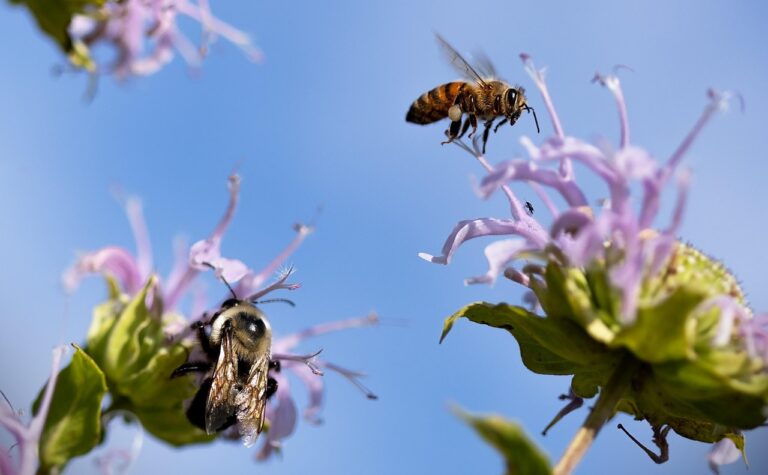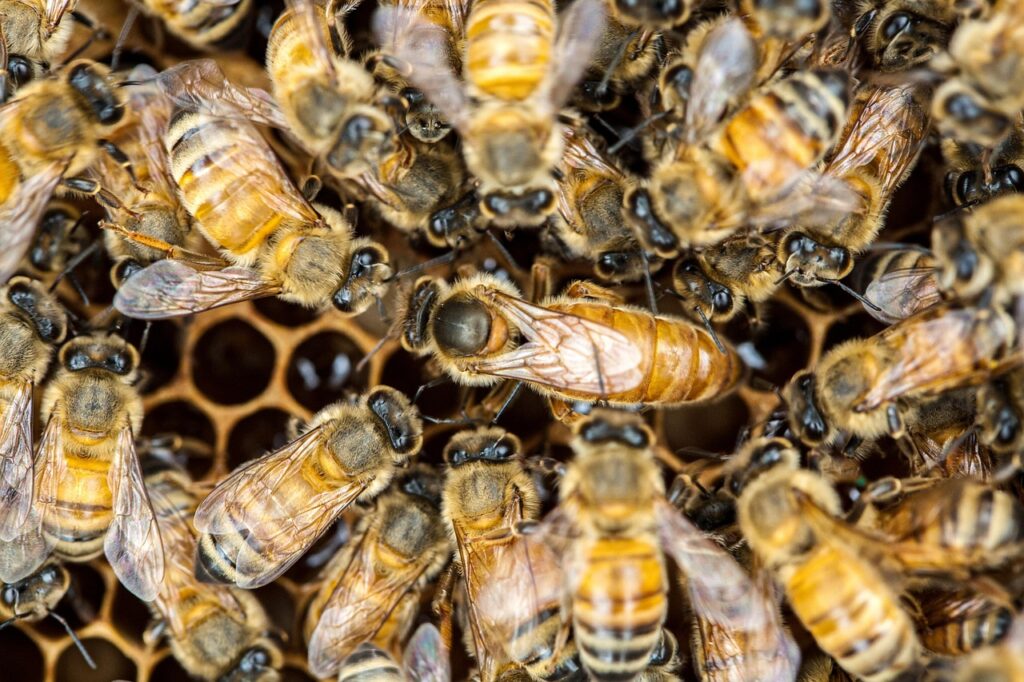Here’s how long bees typically spend foraging each day.
Bees typically spend 10-12 hours per day actively foraging in the field, with their activity spanning from early morning until late afternoon or evening.
However, the exact duration varies significantly based on species, environmental conditions, season, and resource availability.
Daily Foraging Duration
Research shows that the mean foraging duration throughout the year is approximately 11.85 ± 1.79 hours per day[1].
During peak foraging periods, bees can be active for up to 14.22 hours[1], while in cooler months, both foraging duration and intensity decrease significantly[1].
Individual worker bees can spend up to 12 hours a day working – nearly dawn to dusk every day[2].
Bees are most active during the warmest part of the day, typically between 10 am and 4 pm[3], with peak activity often occurring between 12:00 to 14:00 hours[4] or 2:00 pm to 3:00 pm[5].
Foraging Schedule Throughout the Day
Bees follow a predictable daily pattern:
- Morning: Activity begins as early as 8:00 am when the sun warms the environment[6]
- Peak hours: Maximum foraging occurs between **10:00 am an], with the highest activity between 2:00-3:00 pm[5]
- Evening: Activity gradually decreases, ending typically around 5:00-6:00 pm[3] or continuing until sunset[7]
Some species show bimodal activity patterns with distinct morning and afternoon peaks[8][9], while certain species like Apis dorsata may even forage at night under moonlight[7].
Individual Foraging Trips and Time Allocation
While bees may be active for 10-12 hours daily, this doesn’t mean they spend the entire time away from the hive. Individual foraging behavior includes:
- Number of trips per day: Bees typically make 7-13 trips per day (average of 10)[10], though water collectors may make up to 100 trips daily[11]
- Trip duration: Individual foraging trips average approximately 50 minutes[12] for both nectar and pollen collection, though this varies:
- Nectar collection trips: 10 minutes on average[13]
- Pollen collection trips: 30-80 minutes[13]
- Some studies report much shorter trips of 8.6 minutes average duration[14]
The cumulative time spent foraging over a bee’s lifetime ranges from 373.49 to 3,146.99 minutes across different colonies[15], with individual bees typically having foraging careers lasting 7-12 days[16][17].
Factors Affecting Daily Foraging Time
Several environmental and biological factors influence daily foraging duration:
Temperature and Weather:
Bees require temperatures typically between 20°C to 28°C for optimal foraging[8][9]. Cold weather reduces activity, while extreme heat (above 42°C) also limits foraging[6].
Season:
Spring shows the highest foraging activity and longest duration[8][1], while winter activity is minimal and restricted to the warmest midday hours[18].
Resource Availability:
During abundant nectar flows, bees extend their daily foraging hours, while poor resource availability shortens active periods[1].
Colony Needs:
Stronger colonies with more brood to feed typically have longer daily foraging periods and more active foragers[1].
Species Differences
Different bee species show varying daily activity patterns:
- Honeybees (Apis mellifera): 10-12 hours daily activity
- Bumblebees: Average 58.5 ± 2.0 minutes per foraging bout but make more trips, spending more total time foraging daily than honeybees[19]
- Stingless bees (Melipona): Pollen specialists typically active for 1-3 hours per day in early morning[17]
The daily foraging duration represents a critical balance between energy expenditure and resource collection, with bees optimizing their time in the field to maximize colony survival while minimizing individual risk and energy costs.
⁂
- https://indianentomology.org/index.php/ije/article/download/955/1301/8213
- https://www.beepods.com/short-but-mighty-the-stages-of-life/
- https://beehivehero.com/what-time-of-day-are-bees-most-active/
- https://www.entomoljournal.com/archives/2019/vol7issue4/PartR/7-4-227-467.pdf
- https://www.scitepress.org/Papers/2019/73875/73875.pdf
- https://www.bizzybeeexterminators.com/blog/when-are-bees-most-active-and-other-faqs/
- https://bioone.org/journals/tropical-conservation-science/volume-9/issue-3/1940082916667142/Seasonal-and-diurnal-patterns-of-activity-in-honeybees-Apis-spp/10.1177/1940082916667142.short
- https://journals.ekb.eg/article_196712_9fbe3d5136604063102ca7067dc56f8d.pdf
- https://www.apiservices.biz/documents/articles-en/foraging_rhythm_honeybees_eygypt.pdf
- https://en.wikipedia.org/wiki/Honey_flow
- https://www2.gov.bc.ca/assets/gov/farming-natural-resources-and-industry/agriculture-and-seafood/animal-and-crops/animal-production/bee-assets/api_fs111.pdf
- https://www.nature.com/articles/s41598-022-26858-9
- https://adventuresinbeeland.com/2011/03/17/6th-honeybee-behaviour-revision-post-bee-foraging/
- https://www.entomologyjournals.com/assets/archives/2023/vol8issue2/8016-779.pdf
- https://esajournals.onlinelibrary.wiley.com/doi/10.1002/ecs2.4088
- https://royalsocietypublishing.org/doi/10.1098/rsos.200998
- https://citeseerx.ist.psu.edu/document?repid=rep1&type=pdf&doi=1c1213806b077cc93a3d4a0ec1b2ebe1cec136be
- https://thebeesupply.com/blogs/beekeepers-blog/best-time-of-day-conditions-to-inspect-your-hives
- https://www.frontiersin.org/journals/ecology-and-evolution/articles/10.3389/fevo.2018.00156/full



